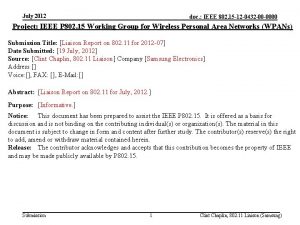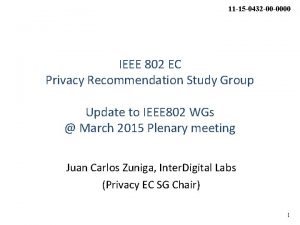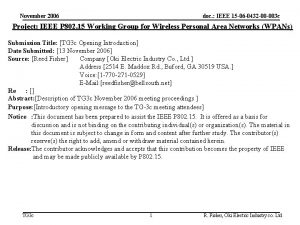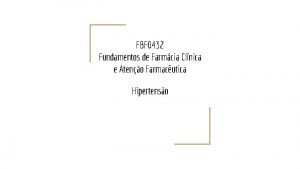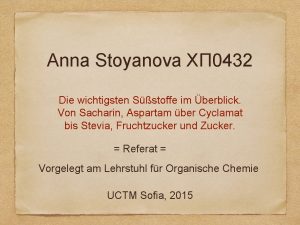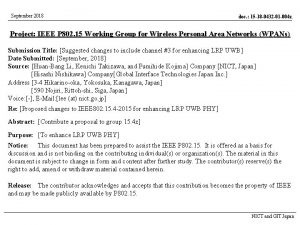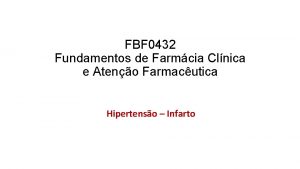July 2013 IEEE 802 15 13 0432 00









![July 2013 IEEE 802. 15 -13 -0432 -00 -004 q References [DOL 98] S. July 2013 IEEE 802. 15 -13 -0432 -00 -004 q References [DOL 98] S.](https://slidetodoc.com/presentation_image_h2/80c44349369694ea9803f7cf34d181f4/image-10.jpg)
- Slides: 10

July 2013 IEEE 802. 15 -13 -0432 -00 -004 q Project: IEEE P 802. 15 Working Group for Wireless Personal Area Networks (WPANs) Submission Title: Benefits of using FEC Date Submitted: July 2013 Source: Frederik Beer 1, Jörg Robert 1; 1 Friedrich-Alexander-Universität Erlangen-Nürnberg, Information Technology Phone: +4991318525123, Fax: +4991318525102 E-Mail: frederik. beer@fau. de Abstract: Some basic considerations about benefits from using FEC Purpose: Notice: This document has been prepared to assist the IEEE P 802. 15. It is offered as a basis for discussion and is not binding on the contributing individual(s) or organization(s). The material in this document is subject to change in form and content after further study. The contributor(s) reserve(s) the right to add, amend or withdraw material contained herein. Release: The contributor acknowledges and accepts that this contribution becomes the property of IEEE and may be made publicly available by P 802. 15. Submission Slide 1 Frederik Beer, Jörg Robert

July 2013 IEEE 802. 15 -13 -0432 -00 -004 q Benefits of using FEC Submission Slide 2

July 2013 IEEE 802. 15 -13 -0432 -00 -004 q Objective • Show possible improvements by using FEC – Calculation of necessary bit error rate (BER) for certain packet error rate (PER) – Show performance of uncoded modulation types – Show possible coding gain • Show the coding gain can be translated into different parameter optimisations – – Submission Efficiency Peak power consumption Range PER Slide 3

July 2013 IEEE 802. 15 -13 -0432 -00 -004 q BER Calculation • Submission Slide 4

July 2013 IEEE 802. 15 -13 -0432 -00 -004 q BER Curves Submission Slide 5

July 2013 IEEE 802. 15 -13 -0432 -00 -004 q Coding Gain • Submission Slide 6

July 2013 IEEE 802. 15 -13 -0432 -00 -004 q Benefits (1) This lower necessary Eb/N 0 can be traded for a variety of benefits • Faster transmission at constant trasmit power – 8. 5 times higher datarates possible – Higher datarates increase overall efficieny of transmission • Reduced transmit power at constant datarate – 12% of the transmit power necessary – Reduced peak power consumption Submission Slide 7

July 2013 IEEE 802. 15 -13 -0432 -00 -004 q Benefits (2) This lower necessary Eb/N 0 can be traded for a variety of benefits • Higher range at constant transmit power and datarate – Depending on the environment range can be extended by factor 2. 9 1. 5 • Lower packet error rates at constant transmit power, datarate and range Submission Slide 8

July 2013 IEEE 802. 15 -13 -0432 -00 -004 q Conclusion • Usage of FEC schemes open up a variety of possibilities • System can be optimised according to its intended use • In order to achieve maximum degree of freedom we suggest to include an optional systematic FEC scheme in 4 q Submission Slide 9
![July 2013 IEEE 802 15 13 0432 00 004 q References DOL 98 S July 2013 IEEE 802. 15 -13 -0432 -00 -004 q References [DOL 98] S.](https://slidetodoc.com/presentation_image_h2/80c44349369694ea9803f7cf34d181f4/image-10.jpg)
July 2013 IEEE 802. 15 -13 -0432 -00 -004 q References [DOL 98] S. Dolinar, D. Divsalar, and F. Pollara. “Code Performance as a Function of Block Size. ” TMO Progress Report 42 -133 (January-March 1998). Submission Slide 10











